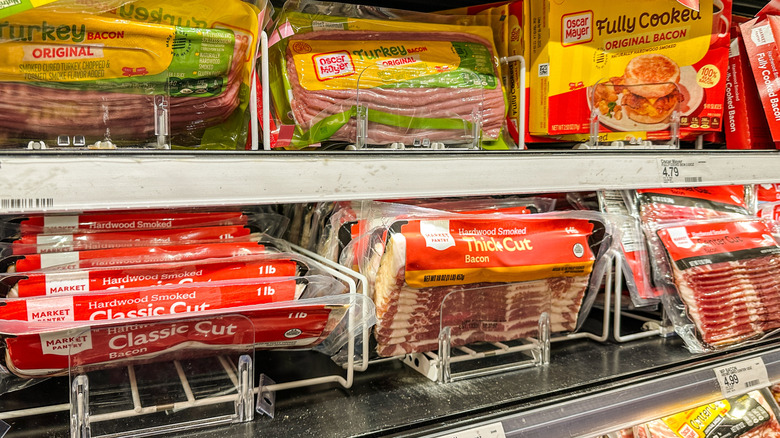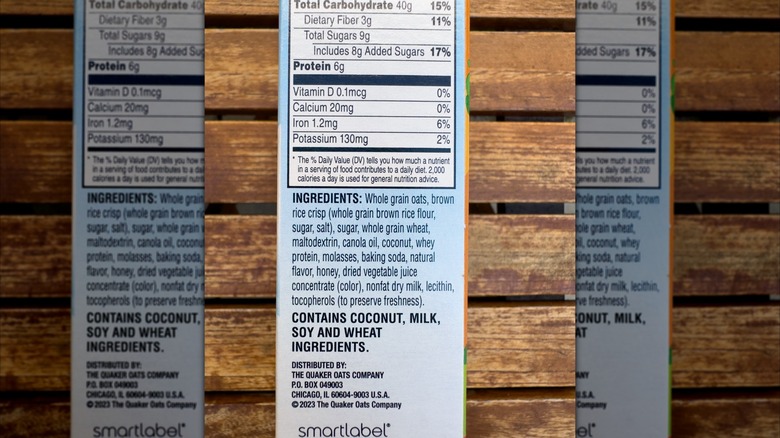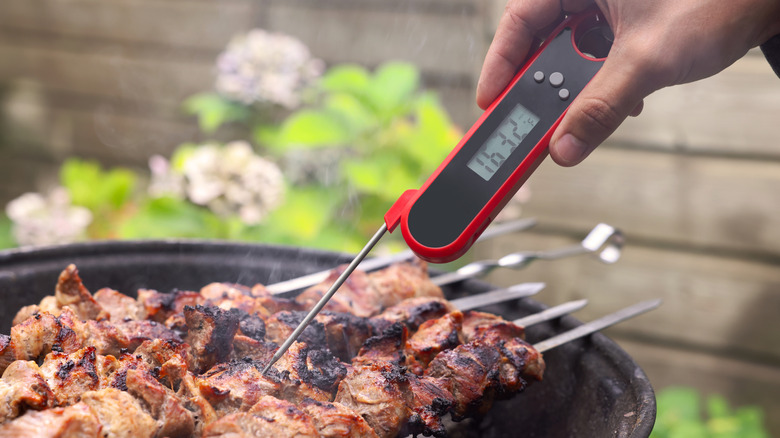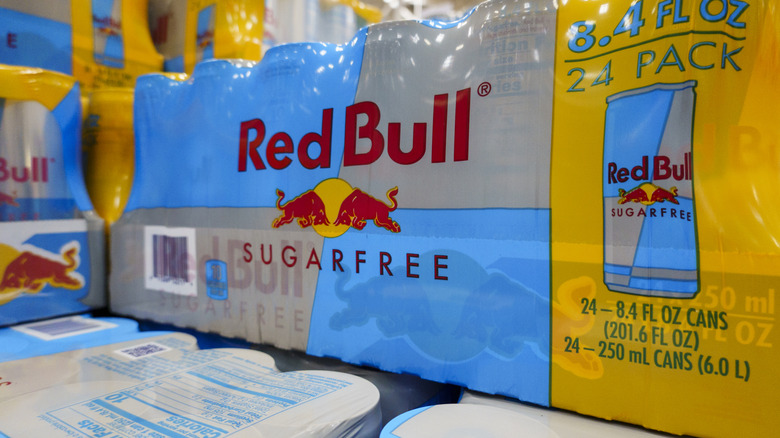11 Food Label Words And Phrases You Should Never Ignore
Food packaging can be a tricky business. We've all purchased what looks like an oversized bag of potato chips only to be disappointed when we pop that bag open and find that it's more air than spud. Or maybe you've fallen for marketing slogans that indicate mothers with specifically high standards always choose a particular peanut butter brand. If Mom thinks it's good enough, certainly this is the best, right?
For the most part, you can ignore packaging ploys like these. Sure, you're not getting as many potato chips as you'd hoped, but no one's getting hurt, and maybe Mom doesn't really think that peanut butter brand's all it's cracked up to be, but it's still a solid choice.
That said, there are a few times you should absolutely pay attention to what's printed on that box, can, or bag of food. Food manufacturers use a range of words and phrases on their labels and, sometimes, those words and phrases can be misleading in such a way that they might result in a negative health consequence. Other times, the chosen verbiage may clue you in to some food safety practices you shouldn't ignore, especially if you want to avoid a nasty foodborne illness. These are the food label words and phrases worth paying attention to, every time.
1. Zero Trans Fat
You probably know that trans fat is bad news. Widely called the worst fat of them all, eating it on the regular can have negative consequences for your cholesterol and raise the risk of cardiovascular disease and stroke. Knowing this, the U.S. government has taken steps to reduce the amount of trans fat in the average American diet. However, that doesn't mean that you're in the clear and can eat whatever you want, whenever you want, with no trans fat worries. It's still popularly found in highly processed food, as well as in fast food — and it's even in food that claim "zero trans fat" on their labels.
Yep, that nutrition label on the back of your food item is allowed to lie, thanks to a handy little Food and Drug Administration loophole. The nutrition label is allowed to say a food contains 0 grams of trans fat if it technically has less than 0.5 grams of trans fat. Good thing there's a way to see if a food manufacturer is using trans fats in its foods, even if it's claiming it's not. Just check out the ingredients list. If you see a partially hydrogenated oil, the food contains trans fat, as the two terms are interchangeable. (Keep in mind you should be looking specifically for partially hydrogenated oil, not seed oils overall; it's a common cooking oil myth that seed oils always contain trans fat.)
2. Reduced
You're comparing similar products on the store shelf and trying to decide which to buy. Maybe you're cutting back on your sodium. Maybe you're avoiding added sugar in your diet. You reach for the packaging that claims the product has "reduced" sodium or sugar. Not so fast, though — you want to actually stop and take a moment to compare products based on nutrition labels, not just the words or phrases used on the front of the package.
The thing is, manufacturers can use terms like "reduced," "less," "fewer," or "lower" to define any product that contains at least 25% less of a certain thing, whether that's sodium, sugar, fat, calories, etc. However, the powers that be don't dictate what manufacturers measure that 25% against. The food could contain 25% less sugar or sodium than the brand's regular version of the product, another brand's version of the product, or a completely different food all together.
As such, if you're really worried about trying to eat less sodium or less sugar, it's important that you actually look at the nutrition labels versus a "reduced" claim. For example, a truly low sodium food should have fewer than 140 milligrams of sodium per serving. Many foods with much higher levels of sodium per serving may say "reduced," as is the case with Progresso's Reduced Sodium Chicken Broth, which still contains 490 milligrams of sodium per serving, technically making it a high sodium food, even if it has less sodium than another product.
3. No nitrates or nitrates added
Nitrates are often used in processed meats as a preservative, where they've been linked to increased risk for certain cancers. However, nitrates are also found in natural sources, like in a range of vegetables, where the other antioxidants and vitamins in those foods limit the nitrates' carcinogenic potential. As such, while you may not worry about nitrates in your spinach, you may make a point to purchase nitrate-free bacon or lunchmeat.
However, it's important to realize that just because a package of bacon uses the phrase "no nitrates" or "no nitrates added," that doesn't actually mean there aren't any nitrates in that bacon. The U.S. Department of Agriculture allows manufacturers to use these terms so long as the nitrates included in the food are not from a synthetic source. If the nitrates were naturally sourced, the package can claim that there are no nitrates included at all. Celery is often used as a source of nitrates for processed meats, so if you spot a celery-derived ingredient in the ingredients list, that's where the nitrates are coming from. And, unfortunately, because foods like bacon are high in protein and low in antioxidants and vitamins, the celery-derived nitrates are just as potentially carcinogenic as synthetically sourced nitrates.
4. California Proposition 65
You've probably picked up a food — or a range of items — that feature the California Proposition 65 warning label. It's the one that says "WARNING: This product contains chemicals known to the State of California to cause cancer, birth anomalies, or other reproductive harm." The warning label is required on products sold in California (though it's found all around the country) that contain one of the near thousand chemicals that the state has deemed a risk to the public.
Foods that might feature a Prop 65 warning include fish that contain mercury, alcoholic beverages, ingredients that include lead, rice that contains inorganic arsenic, and more. While it's generally agreed that eating a food with a Prop 65 warning label isn't going to make you drop dead immediately, the wording is still something to consider, both in the context of what you're consuming and the context of your overall diet. For example, if the warning label is on a can of seafood, you might consider how much mercury you're consuming on a regular basis and whether or not it's going to pose a health risk. Maybe you start to opt for fish with lower mercury levels, such as low-mercury sardines or some of the canned tuna brands that come with the lowest mercury levels.
5. Contains
If you have a food allergy, you're not alone. According to the Food Allergy Research & Education (FARE) organization, approximately 33 million Americans have a food allergy, which works out to about 10% of all adults and about 8% of all children, with more than half of all the adults with food allergies reporting having experienced an extreme reaction to their allergen in the past. Furthermore, claims of anaphylactic food reactions — which can quickly turn life-threatening — have gone up. Plus, food allergies are a big reason for food recalls.
As such, it's extremely important for anyone with a food allergy to check out all packaged food for a "Contains" statement on the nutrition label. The U.S. Food and Drug Administration (USDA) requires food manufacturers to place a "Contains" statement after or beside the list of ingredients in the food, stating all major allergens that are found in that food. If the manufacturer does not do this, they must list the allergens clearly within the list of ingredients (so it's important that, even if a food label does not include a "Contains" statement, that you read the list of ingredients anyway). The USDA requires this labeling for the following allergens: milk, egg, fish, shellfish, tree nuts, wheat, peanuts, soybeans, and sesame.
6. Refrigerate after opening
You have a pantry item. Maybe it's a condiment or it's a can of ready-to-eat food. You didn't buy it from the refrigerated section at the grocery store and you're storing it right in the kitchen cabinet. However, the packaging tells you to refrigerate the food once you open it. What's the big deal? Why do you have to refrigerate now, even though you never had to before?
In a TikTok video, TheBlackfoodscientist breaks it down, explaining that items that sit on the store shelf or in the pantry that say "refrigerate after opening" are known as "commercially sterile" products. These products have been processed in such a way that they've basically been sterilized, with all pathogenic microorganisms killed, removing the risk of spoilage and related foodborne illness. However, once you open up that packaging, you expose the food to microorganisms within your environment — even just in the air! Putting the item in the fridge helps significantly slow the growth of those microorganisms.
Unfortunately, as an FDA report from the 1990s noted, a lot of consumers do not understand the full consequences of not refrigerating their foods, because some manufacturers will include some verbiage after "refrigerate after opening" along the lines of "for best quality." This could lead consumers to think that refrigeration is optional — but the FDA cautions that it's really not.
7. Cook to an internal temperature of
You may be pretty strict about making sure certain foods are cooked to the right temperature. You know that undercooked chicken is a recipe for salmonella, so you always break out the food thermometer when you're roasting a whole bird or searing a chicken breast, for example. However, do not overlook the "cook to an internal temperature of" warning on packaged foods.
For instance, you might think that a frozen food that you're just going to pop into the microwave doesn't really require much thought as to food safety. However, freezing food does not kill bacteria. Instead, freezing just renders it inactive, so it can't grow during storage. Once the food rises in temperature, into the danger zone of 40 to 140 degrees Fahrenheit, the bacteria begin to grow again. That means that if you don't heat your frozen food to the correct temperature, it could cause foodborne illness. Most frozen foods will tell you to heat them to at least 165 degrees Fahrenheit.
The one type of packaged food that you don't really have to worry about heating? Canned foods, as commercially canned foods — not home-canned foods! — can be enjoyed straight from the can, so long as the can is in good condition.
8. Processed in a facility that also processes
If you're keeping an out for allergens that pose a risk to you, when buying packaged foods, you want to look out for more than just allergens in the ingredients list or as part of a "contains" statement. Some foods may also include a statement along the lines of "Processed in a facility that also processes [insert allergens]." However, the U.S. government guidelines are different for these types of statements than they are for "contains" statements and similar.
If a food manufacturer declares that a product was made in a facility that also processes certain allergens, they do so completely voluntarily, as the government does not require this type of warning. When the manufacturer uses this phrasing, or the similar "may contain," it means that the product itself should not, by its nature, contain the allergen, but another product containing the allergen may have been processed on the same equipment, for example, which can lead to cross-contamination.
For those with a severe allergy, they'll want to avoid products that run this risk of cross-contamination. Additionally, because adding a statement like this is voluntary and not required, you may likewise want to go the extra length to contact a brand directly, to ensure no cross-contamination is possible.
9. Wheat-free
For those who've never had a gluten sensitivity or Celiac disease, or who don't really know someone closely who does, it can be easy to think that "gluten-free" is just the same thing as "wheat-free," but that couldn't be further from the truth. And not paying attention to the difference when purchasing and then serving food can have major consequences.
Gluten is a protein that's present in wheat, but it's found elsewhere, too, such as in barley and rye. So, if someone is sensitive to gluten, they can't eat wheat, barley, or rye. They also can't tolerate wheat-related food, such as bulgur, farro, spelt, and semolina. However, someone can be sensitive or allergic to just wheat only, and thus be able to tolerate gluten just fine.
But don't think that if someone with Celiac disease eats a wheat-free, gluten-containing product that the worst that could happen is just a little tummy ache. When someone with Celiac disease eats gluten, the body recognizes it as a threat and the immune system begins to attack, harming healthy cells along the way. This results in variety of gastrointestinal distress, as well as pain and even long-term mental health issues. The individual may need to take as many as a few days off work to recuperate.
10. Sugar-Free
While the FDA does have some regulatory guidelines around what can be considered "sugar-free," this is another one of those phrases, like "less sugar," that you'll want to pay attention to if you're trying to cut down the sugar in your diet due to health reasons. Across the food industry as a whole, the term "sugar-free" can be used in ways that aren't entirely honest, something the FDA admits and is monitoring.
For example, some may consider "sugar" to only be white sugar, so if a product doesn't have white sugar in it, it may be marketed as sugar-free. However, it can still contain other sweeteners that are considered more natural, like honey, dates, or agave nectar, or sugar substitutes like xylitol or aspartame. Additionally, some products may be labeled as "sugar-free" when it really means "no added sugar." There are many products — like fruit juice — with no added sugar that have already existing sugar, so they're not truly sugar-free. Additionally, just like technically manufacturers are allowed to say a food has zero trans fat if it contains a small enough amount of trans fat, the FDA allows manufacturers to label a food as sugar-free if it contains less than 0.5 grams of sugar per serving.
11. Use By
"Best by" dates on foods have been a source of confusion for a while now. The U.S. government's official stance is that "best by" dates are all about quality, not safety, with the only exception being infant formula. As such, the government doesn't require "best by" dates on foods and manufacturers can use a range of terms such as "best by," "sell by," "use by," or "freeze by."
However, due to the massive amount of food loss that occurs because consumers are just confused about these dates and end up throwing out food before it's truly spoiled, some states are changing up the status quo — and others may be following suit. As such, you may want to actually start paying attention if your food specifically says "use by."
Starting in July 2026, anytime California residents see "use by" labels on foods, they'll be able to know that is a safety-related date, not a quality-related date. After the "use by" date has passed, consuming the product will come with an elevated health risk. Other states are also considering similar actions, including Illinois, Massachusetts, New Jersey, and South Carolina.











